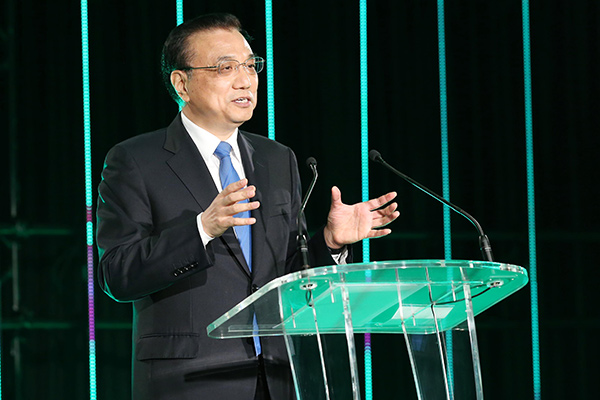China's advantage in approaching Australia and New Zealand
- By George N. Tzogopoulos
 0 Comment(s)
0 Comment(s) Print
Print E-mail China.org.cn, March 31, 2017
E-mail China.org.cn, March 31, 2017
|
|
|
Premier Li addresses a welcome banquet on March 28 in Aukland. [Photo/Xinhua] |
A Chinese multidimensional foreign policy is clearly emerging, and the implementation of its "Belt and Road" policy forms part of establishing an extended network and forging harmonious relations with countries where the ancient Silk Road is being revitalized.
However, the Asian-Pacific region naturally constitutes one of the areas on which the Chinese administration is steadily focusing. There is no better example than the visit of Premier Li Keqiang to Australia and New Zealand.
Both Australia and New Zealand are significant for the evolution of trade, the signing of new business deals and the potential creation of joint ventures. The entrance into force of bilateral free trade agreements with China - signed in 2015 and 2008 respectively - facilitates this process.
Hence, Premier Li discussed with his Australian and New Zealand counterparts Malcolm Turnbull and Bill English how best to work with them to cover more sections of the economy or seek significant upgrades.
A simple Internet search of sources from Australia and New Zealand provides numerous results showing the benefits stemming from their free trade agreements with China.
At this juncture, however, every discussion about economic collaboration has a wider dimension that goes beyond profitability. Canberra and Wellington had invested heavily in making a success of former U.S. President Barack Obama's initiative to establish the Trans-Pacific Partnership (TPP).
However, President Donald Trump had hardly settled into office before he scuttled the TPP as far as America was concerned, effectively destroying it.
In the aftermath of Trump's decision, Australia and New Zealand need to readjust their policies. China's led scheme - the Regional Comprehensive Economic Partnership (RCEP) - could perhaps take over from the TPP.
Its proposal for a free trade area in the Asia-Pacific region, as reiterated by President Xi Jinping during the APEC Summit last November in Lima, constitutes a step forward. For its part, Australia is refocusing on a post-TPP multilateral trade bloc with a Chinese rather than US centerpiece. New Zealand is also elaborating on its stance to this "Plan B."
Irrespective of the form the new multilateral trade agreement in the Asia-Pacific region will take, what is currently more important is that China seems to be the driving force. This is happening not only because of the American withdrawal from the TPP but because the Trump administration is employing an anti-globalization rhetoric.
Its emphasis on "free and fair trade" entails a preference for bilateral deals and an opposition to multilateral ones, whether they happen to be the TPP, the Transatlantic Trade and Investment Partnership (TTIP) or the North American Free Trade Agreement (NAFTA).
As things are developing after Trump's inauguration, China has remained the most powerful supporter of globalization. President Xi set the tone during the Davos World Economic Forum sparking much international analysis.
Australia and New Zealand are well aware of the new reality. This has been apparent during the meetings between Li and his counterparts in Canberra and Wellington respectively. Turnbull summed it up well: "Protectionism is not a ladder to get you out of a low growth trap - it's a big shovel to dig it deeper."
From another perspective, the evolution of Sino-Australian and the Sino-New Zealand relations will be critical to explore how two pro-Western countries will accommodate Chinese and American strategic interests.
Vice President Mike Pence is expected to visit Australia in mid-April - maybe in an attempt to increase the influence of his country after the TPP setback. So far, no plans for a New Zealand visit have been announced.
On the whole, there is a traditional suspicious tendency by Washington vis-à-vis China's move to invest in the infrastructure of other countries. Australia and New Zealand are no exception.
Canberra and Wellington have not been prepared to see themselves caught up in the alleged Sino-American rivalry. On the occasion of Li's visit, Malcolm Turnbull clarified that his country "does not have to choose between the U.S. and China." For his part, New Zealand Trade Minister Todd McClay said closer ties with Beijing need not affect relations with Washington.
These messages are certainly positive. Whether they are realistic though remains to be seen in the future.
China is carefully monitoring U.S. reactions to the implementation of its "Belt and Road" policy. However, as long as this initiative is bringing "win-win" results for China and its partners, Washington can hardly block it.
George N. Tzogopoulos is a columnist with China.org.cn. For more information please visit:
http://www.ccgp-fushun.com/opinion/GeorgeNTzogopoulos.htm
Opinion articles reflect the views of their authors, not necessarily those of China.org.cn.






